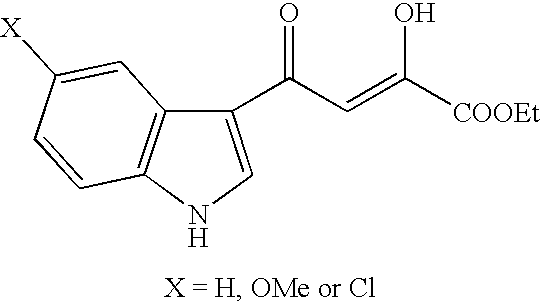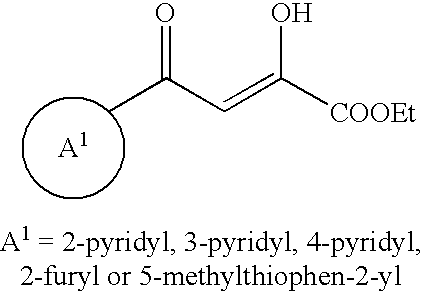Heteroaromatic derivatives having an inhibitory activity against HIV integrase
a technology of heteroaromatic derivatives and inhibitors, which is applied in the field of heteroaromatic derivatives having an inhibitory activity against hiv integrase, can solve the problem that the retrovirus vector derived from mlv can only infect proliferating cells
- Summary
- Abstract
- Description
- Claims
- Application Information
AI Technical Summary
Benefits of technology
Problems solved by technology
Method used
Image
Examples
example 1
##STR42##
1-[(1-Benzyl-5-ethoxycarbonyl)pyrrol-3-yl]-3-hydroxy-3-(1H-1,2,4-triazol-3-yl)-propenone (Compound No. I-1)
(1) To pyrrole-2-carboxylic acid (2.2 g, 20 mmol) were added at room temperature thionylchloride (2 ml, 27.4 mmol) and DMF (0.5 ml). The mixture was heated at 50.degree. C. for 30 minutes. An excess of thionyl chloride was evaporated under reduced pressure. The residue was dissolved in toluene (5 ml) and evaporated under reduced pressure again. This procedure was performed three times. After that, the residue was dissolved in chloroform (10 ml), and the solution was added dropwise at room temperature to ethanol (20 ml) and stirred for 30 minutes. The reaction mixture was concentrated. The residue was chromatographed on silica gel (hexane:ethylacetate=1:1 v / v). The fraction of the objective was concentrated to give 2-ethoxycarbonylpyrrole (2.9 g) as an oil quantitatively
NMR(CDCl.sub.3) .delta.: 1.36 (3H, t, J=7.0Hz), 4.33 (2H, q, J=7.0Hz), 6.22-6.31 (1H, m), 6.89-6.98 (...
example 2
##STR43##
1-[(1-Benzyl-5-carboxy)pyrrol-3-yl]-3-hydroxy-3-(1H-1,2,4-triazol-3-yl)-propenone (Compound No. I-2).
(1) To a solution of 1-[(1-benzyl-5-ethoxycarbonyl)pyrrol-3-yl]-3-hydroxy-3-(1H-1,2,4-triazol-3-yl)-propenone (150 mg, 0.41 mmol) obtained in Example 1 in dioxane (10 ml) was added 2 N NaOH (1 ml). The solution was stirred at 50.degree. C. for 30 minutes. The reaction mixture was concentrated under reduced pressure. The residue was partitioned between ether (10 ml) and water (10 ml). The water layer was separated and washed with ether, and then acidified with 2 N HCl. The extract with ethylacetate was washed with water and dried. The solvent was evaporated. The obtained yellow powder was recrystallized from ethylacetate to give the titled compound (100 mg) Yield: 74%.
M.p.: 264-265.degree. C.
Elemental analysis for C.sub.17 H.sub.14 N.sub.4 O.sub.4 0.3 H.sub.2 O Calcd. (%): C, 59.40; H, 4.28; N, 16.30. Found. (%): C, 59.21; H, 4.30; N, 16.20.
NMR(d.sub.6 -DMSO) .delta.: 5.63 (2...
example 3
##STR44##
1-[1-(4-Fluorobenzyl)pyrrol-2-yl]-3-hydroxy-3-(2H-tetrazol-5-yl)-propenone (Compound No. I-3)
(1) To a suspension of sodium hydride (60% in mineral oil, 1.32 g, 33 mmol) in DMF (30 ml) was added at an ice bath temperature a solution of 2-acetylpyrrole (3.27 g, 30 mmol) in DMF (5 ml). The mixture was stirred at room temperature for 15 minutes and cooled again. To the solution was added dropwise a solution of 4-fluorobenzylbromide (6.24 g, 33 mmol) in DMF (2 ml). The reaction solution was stirred at room temperature for 1 hour and poured into ice-water, and then extracted with ethylacetate. The ethyl acetate was washed with water and dried. The solvent was evaporated to give 2-acetyl-1-(4-fluorobenzyl)pyrrole (6.5 g) as an oil quantitatively.
NMR(CDCl.sub.3) .delta.: 2.41 (3H, s), 5.53 (2H, s), 6.18-6.22 (1H, m), 6.88-7.14 (6H, m).
(2) To a solution of the above-obtained compound (1.1 g, 5 mmol) in THF (20 ml) was added under -65.degree. C. a solution of lithiumbistrimethylsilyl...
PUM
| Property | Measurement | Unit |
|---|---|---|
| temperature | aaaaa | aaaaa |
| temperature | aaaaa | aaaaa |
| temperature | aaaaa | aaaaa |
Abstract
Description
Claims
Application Information
 Login to View More
Login to View More - R&D
- Intellectual Property
- Life Sciences
- Materials
- Tech Scout
- Unparalleled Data Quality
- Higher Quality Content
- 60% Fewer Hallucinations
Browse by: Latest US Patents, China's latest patents, Technical Efficacy Thesaurus, Application Domain, Technology Topic, Popular Technical Reports.
© 2025 PatSnap. All rights reserved.Legal|Privacy policy|Modern Slavery Act Transparency Statement|Sitemap|About US| Contact US: help@patsnap.com



